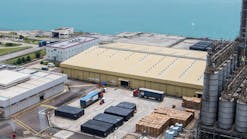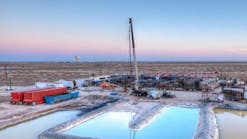BP and Chevron may decide next year to develop Sourdough field adjoining the Arctic National Wildlife Refuge (ANWR) Coastal Plain, but the Clinton administration remains steadfast in opposition to ANWR drilling.
Sen. Frank Murkowski (R-Alas.), who favors opening ANWR to exploration, said last week it might be prudent to allow some drilling on the edge of ANWR. But Interior countered: "We feel we will be able to work with the two oil companies and establish the amount of federal drainage" without drilling in ANWR.
The public comment period for U.S. EPA's controversial smog and soot rule (OGJ, Mar. 10, 1997, p. 30) has closed.
EPA received comments at four pubic hearings, plus more than 17,000 letters, 30,000 E-mail messages, and 15,000 calls to a special phone number.
API urges EPA to retain the current limits because proposed standards on fine particles will not produce "any measurable health benefits," while the National Petroleum Refiners Association says EPA has not given the public all the facts (see related story, p. 24).
NPRA says the scientific community contends a new ozone standard is not needed, adding many areas of the U.S. will never be able to meet the new standard.
There is major oil and gas legislative activity under way in key U.S. producing states.
In Texas, legislators are mulling transferring all duties of the state's utility commission (PUC) to the Texas Railroad Commission (TRC).
S.B. 1768 seeks to merge the PUC with the TRC.
The TRC, meanwhile, has a lot of thorny issues on its plate, including trying to advance a code of conduct that would affect producers, gatherers, and intrastate pipelines.
Raised as an issue in 1996 by certain independents, as well as the Texas Independent Producers & Royalty Owners Association, as a proposed rulemaking, the current rulemaking effort seeks to provide more information for all parties to level the playing field over issues involving rate discrimination and pipeline access-"probably the most difficult issue the Railroad Commission has ever taken on," said TRC Chairman Charles R. Matthews, who also favors combining PUC and TRC.
A full commission hearing on the proposed code of conduct is scheduled for Apr. 22. A draft is scheduled to be approved for circulation Apr. 15.
In Oklahoma, officials are considering removing all oil and gas and energy functions now under the Oklahoma Corporation Commission (OCC) and ultimately placing them under a new Oklahoma energy commission structure.
The Oklahoma Energy Reform Act (S.B. 600) is expected to be heard in a House committee before the end of March.
Legislation seeks to combine the oil and gas, underground and aboveground storage tank, and fuel divisions of the OCC with the Oklahoma Liquefied Petroleum Gas Board, Oklahoma Department of Mines, and alternate fuels technician programs, currently residing in the state's Department of Central Services, essentially leaving OCC with only utility oversight.
It would create a nine-member Energy Commission Board, oil and gas and fuels advisory councils, and an Energy Administration Court (EAC), which would exercise judicial and quasi-judicial powers of the agencies to be combined. Appeals from the EAC would be to the State Supreme Court.
An Interstate Oil and Gas Compact Commission (Iogcc) study indicates states have been successful in promoting energy resource recovery.
The report said programs in Texas, North Dakota, Kansas, and Montana have used tax incentives or other methods to encourage production of oil and gas that otherwise would not have been extracted.
Iogcc said Texas' program to return inactive wells to producing status has generated about $1.65 billion in economic benefits. Iogcc will use the report in drafting a proposed National Oil and Gas Policy.
Growth in world LPG supply through 2005 will barely outpace demand, said Purvin & Gertz last week at its international LPG seminar at The Woodlands, near Houston.
World LPG supply will grow at 3.5%/year, to about 240 million metric tons in 2005 from about 170 million tons in 1995. World LPG demand will grow through 2005 at 3-3.5%/year. By 2005, demand will have grown to 230 million tons/year from nearly 160 million tons in 1995.
The largest demand growth will occur in Middle East petrochemical markets and in Asian residential/commercial use.
This latter demand area is being driven almost entirely by surprising growth in Chinese residential and commercial markets.
Another surprise, says Purvin & Gertz, is the apparent resurgence in demand for LPG as an auto fuel both in industrial and developing nations.
The largest supply growth will occur outside North America and western Europe. Purvin & Gertz expects African supply to grow about 7.5%/year through 2005, Oceania 6%/year, Latin America and Asia 5%/year, and the Middle East 4%. North American and western European supplies are expected to grow at barely 1%/year.
Preliminary results of a survey of U.S. refiners addressing the quality of crude entering their plants reveal 37% have no formal crude-quality program at any level of their operating or corporate structures.
Findings were released at the recent API pipeline conference at Dallas.
About a third (38%) has some formal program at either the refinery (16%) or corporate (22%) level, while only a quarter has some program at both levels.
The survey revealed average annual spending at each refinery reached more than $300,000 for monitoring and testing of crude-oil quality.
As much as $125,000 was being spent inside refineries, $200,000 outside. Most refineries surveyed test at the delivery point, but respondents expect to increase outside-plant testing.
Most measurements have been for bottoms sediment and water, gravity, and sulfur content.
Almost three-quarters (71%) feel crude oil quality will become more important in coming years, and 75% plan to spend more in the next 5 years on crude oil quality.
The survey by Ernst & Young Wright Killen drew responses from refiners representing 51% of U.S. refining capacity. It was sponsored by the Refiners Crude Oil Quality (RCOQ) working group, formed in 1994 to address recurring problems in the quality of oil being delivered by pipelines.
A full report is scheduled for release by Apr. 1 to RCOQ members, and a general report will also be available.
BP is close to selling its 199,500 b/d refinery at Lavera in southern France, but it discounts reports that the site has significant levels of subsurface contamination.
A European refining official told OGJ the Lavera complex has hydrocarbon contamination beneath the plant, penetrating as deep as 20 ft in some areas.
A Dames & Moore study indicates cleanup costs could be substantial, the official said. Dames & Moore confirmed only that a report has been done, deferring further comment at BP's request.
"It is not an exceptionally contaminated site," a BP Finance official told OGJ last week. BP Finance is handling the divestiture.
BP maintains the sale stems from European refining rationalization and refining overcapacity in that region of France.
The OGJ source said BP is negotiating with a group led by the plant's manager to buy it for a nominal price and assume any environmental liability.
"We're in advanced negotiations with someone...an entity," BP said.
South Africa's Sasol and Exxon appear to be main contenders to form a venture with Qatar General Petroleum Corp. (QGPC) to build a gas-to-liquids plant at Qatar's Ras Laffan LNG complex (see related story, p. 28).
QGPC is looking to use some of the gas produced from supergiant North field to convert into readily marketable diesel fuel.
Sasol, considering a two-train complex at Ras Laffan with a capacity to produce 20,000 b/d of liquid fuels, has been successfully producing diesel at a 2,500 b/d pilot plant in South Africa (OGJ, Mar. 17, 1997, p. 23).
Gas-to-liquids processes are increasingly being viewed as alternatives to LNG in developing remote gas finds and utilizing gas being flared.
Capital costs of a single-train, 10,000 b/d plant are pegged at $300 million. Total development time is about 4 years.
Copyright 1997 Oil & Gas Journal. All Rights Reserved.


